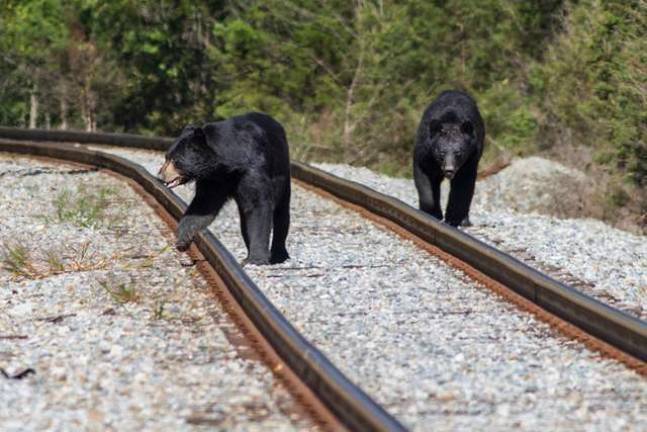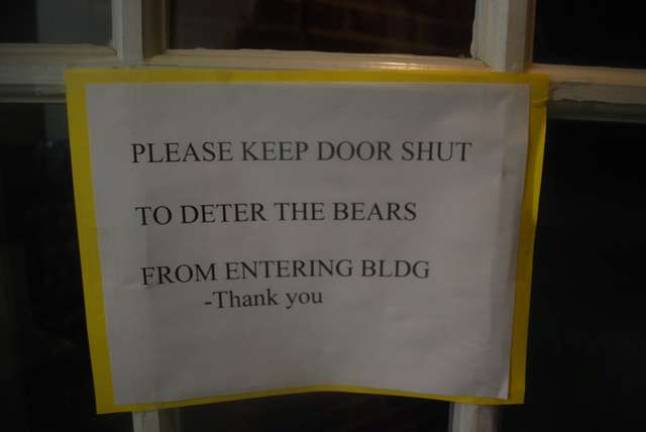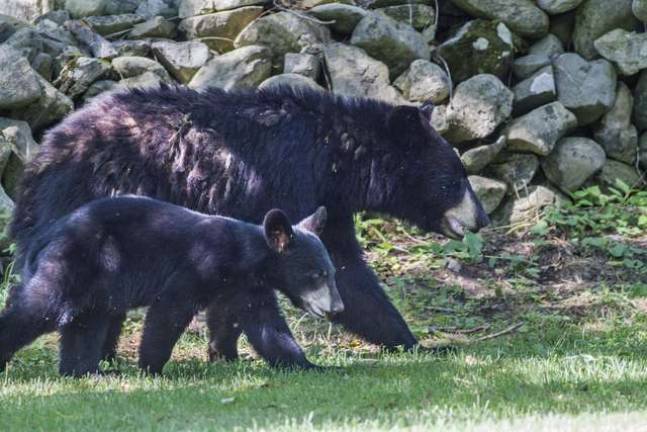Deep in bear country: What now?



On a September afternoon, five men from southern New Jersey went hiking in the woods of northwest Jersey. Not long after they entered the nature preserve they met a couple hiking down the trail, who warned them of a black bear ahead. The group decided to keep going, and soon spotted the bear. They took cell phone pictures. When the bear started following them, they turned around and headed out the way they’d come, eventually breaking into a run as the bear closed the distance.
Only four made it out. Police found the body of the fifth hiker, 22-year-old Rutgers student Darsh Patel half a mile into the preserve in a grassy ravine, his sweatpants, phone and socks stuck to nearby briars, a sneaker on a ridge line 20 yards north of the trail, and his eyeglasses 10 to 15 feet away. Parts of Patel’s body and scalp had been eaten. Police shot and killed the bear lingering nearby.
The bear had human blood on its front paws and in its mouth, human flesh in its mouth and esophagus and small amounts of human flesh and hair and clothes in its stomach, according to a necropsy by the Northeast Wildlife DNA Laboratory in East Stroudsburg, PA. The 302-pound male was healthy and in “good nutritional body condition,” according to a second necropsy by the New Jersey Animal Health Diagnostic Laboratory.
It was the first time a bear has ever been linked to a human death in New Jersey. Regionally, the one other death by bear in recent memory occurred in New York’s Catskills in 2002, when a young black bear snatched a five-month-old baby from its stroller and then dropped it, killing the baby.
What happened in the Apshawa Preserve of West Milford is still under investigation. More details will emerge when Patel’s autopsy comes back and police release the un-redacted police report, which gives the other hikers’ eyewitness accounts. What is clear is that this historic incident is going to widen the rift that’s already splitting the residents of bear country.
It’s got to be a hard job.
A day after Patel’s death, Dave Golden was getting barraged. It was the Q&A part of the “Living with Black Bears” presentation, which had been scheduled before Patel’s death, but which was now attended by a camera crew from CBS News and maybe 40 West Milford residents with strong opinions.
“You people have no concept of what we are enduring in our day to day lives,” said Celeste Hampton, who runs a local 4-H club. She talked about a kid in her club who had a bear in her basement, and another whose grandmother’s two goats were killed by a bear. “Our livestock is being marauded, and now people are being killed, and you’re telling us to live with these bears,” she said in a loud voice, breathing heavily.
“It’s pretty upsetting to all of us,” said Golden, chief of the Bureau of Wildlife Management for the New Jersey Division of Fish & Wildlife. “Here we are, managing a species in the most densely populated state.” While New Jersey is getting to be known as bear country, it’s less famous for being the state most densely populated by that other large land mammal, humans.
A soft-spoken biologist in khakis, green collared shirt and beige tie, Golden represents the wildlife managers across the country whom we expect to toe the line between keeping us safe from harm as populations of large wild animal rebound and to keep wild ecosystems wild— and to do it with minimal resources. The Division of Fish and Wildlife is funded exclusively by hunting and fishing licenses.
Bears and people have gotten so used to living cheek-by-jowl in New Jersey that at campsites, the recommendation is to keep coolers in your trunk or put a blanket over them if they’re in the body of the car. Bears know what coolers look like and will break into cars to get at them. Some residents swear the bears know Thursday is garbage pickup day.
“We can’t control the bears,” said Golden. “We fought very hard before 2010 to get a hunting season because we are above carrying capacity.”
As if to prove the point, in the weeks since Patel’s death, black bears have been a mainstay in the news. A dog walker found a dead cub in Central Park, which investigators said appeared to have been struck by a car. A car killed a juvenile black bear on a Friday evening in a New York suburb near Harriman State Park. Schools in Ridgewood, New Jersey went into lockdown in reaction to a sighting of a black bear, which climbed a tree and was eventually tranquilized.
In 2010, in an effort to deal with its growing bear population, New Jersey reinstated bear hunting, with a six-day season to run for five consecutive years. The fourth hunt is slated for December 8 through December 13, 2014. About 2,800 black bears roamed northwest Jersey as of the DEP’s last count in 2011, down from about 3,400 in 2010. (The count, which uses complaint calls to extrapolate bear population, is controversial.)
The hunt is necessary, says Golden. “How can you manage a population without being able to harvest a portion of that population?” he said.
The majority of the locals at the presentation seemed to be in favor of the bear hunt. Some suggested expanding the hunt, or making it earlier in the season, when more bears would be out and about. One pointed out that the Apshawa Preserve, where Patel was killed, is among the privately owned tracts where hunting is not allowed. That factor may have been one in a confluence of circumstances – including a nut shortage and a time of year in which bears are especially ravenous – that led to this freak event.
The hunt would probably result in more dead bears if it happened in the fall, Golden said, but the thought of killing pregnant females would be “unacceptable” to the public.
Unacceptable is an understatement. New Jersey’s black bear hunt has proven to be one of the most controversial issues in wildlife management history. While Golden is no stranger to being yelled at, usually he’s being shouted down for allowing bears to be killed.
“There’s people out there that say horrible things about us and our staff because they feel a hunt is murderous,” said Golden.
“Our work just got harder for us,” said Angi Metler, presiding over the monthly meeting of New Jersey’s Bear Education and Resource (Bear) Group at the Hillcrest Community Center in West Milford. These are the folks you may have seen standing on the roadside during hunting season with “Honk if you love bears” signs. Patel’s death, they know, is a tragedy that will reverberate for a long time.
In a forgotten classroom at the end of a dimly lit hall, 16 members, some sporting vegan and animal rights pins, compared notes on the considerable research they’d done. They’d not only read the police reports and listened to the 9-1-1 calls but had dug up an article from an Indian expat newspaper about the incident, found a YouTube video of Patel during happy times (“heartbreaking”), gone and hiked the trail, perused all 604 comments on a Rutgers message board, and were talking about taking legal action to get ahold of the un-redacted police report. They want to know everything about what happened in that preserve.
Upon this reporter’s entrance, a man in Tevas immediately asked if I knew anything about the other four hikers who were with Patel, whose names haven’t been released. (Nothing more than they already knew.)
The obvious conclusion being trumpeted in headlines is that the bear mauled and killed Patel, but as group members paint other possible scenarios, that assumption comes to seem irresponsibly premature. Could Patel have fallen to his death while running away, and the bear only then eaten parts of his body? That the trail can be treacherous is highlighted by the fact that last year, a 51-year-old hiker who didn’t come home was found dead in this preserve.
Whatever comes out (or doesn’t), the Bear Group will stay the course and continue to oppose the hunt. To that end, Metler is leading a contingent of 10 to Trenton the next day to protest.
Metler will go to extremes to defend bears. On a hike years ago, she and fellow Bear Group member Susan Kehoe heard screaming and found a bear stuck in a snare trap, which the DEP uses to study bears. They went home and got bolt cutters, and an admittedly nervous Metler bent down and snipped the wire. The group is pressuring the state to use more humane traps.
Hunting bears doesn’t work, the Bear Group says. It is not only ineffectual at reducing nuisance bears, but may even be counterproductive.
Bears are “a self-regulating species,” Metler, a health care practitioner, explained. Their fertility rate is determined by the availability of food and habitat. If a sow isn’t fat enough at the onset of hibernation, she will re-absorb her embryos. Mandating bear-proof garbage cans and dumpsters, as has been done in Wyoming, Colorado and Alaska, would provide “contraception in a can.” The hunting practice of baiting bears, meanwhile, can actually have the unintended consequence of making sows more prolific.
On top of that, it’s orphaned bears that often cause the most trouble, the group says, pointing to a study by the Canadian government showing yearlings that lack foraging experience end up at dumps and campsites.
The number one solution, they say, is education.
This is where everyone agrees. We all need to know more about bears. This was a one-in-a-million bear, an “El Diablo” bear, as one hunter put it. Still, had the hikers known more: that a bear —especially one acting strangely — should be avoided, and that you should never run from a bear, tragedy might have been averted.
West Milford residents know a lot about bears at this point. They know what it means when a bear huffs or paws the ground. Some huff right back.
But the rest of us have gotten pretty dumb about wildlife in general, and bears in particular. None of us grew up with real bears – just the teddy and Smoky and Berenstain varieties.
“What I say in the talks that I give is that pets have become the new children, and wildlife have become the new pets,” said Jim Sterba, the Hudson Valley-based author of The Nature Wars: The Incredible Story of How Wildlife Comebacks Turned Backyards into Battlegrounds (2012).
“We’re out in the middle of all this wildlife, including bears, but we’re really isolated from it with our little screens,” he said. When we encounter the real version, neither people nor animals know how to interact.
People-wildlife conflicts are a manifestation of the conservation movement’s massive success at bringing species back, sometimes from the brink of extinction: bears, mountain lions, wolves, moose. “They’re all headed our way,” said Sterba, and there are only going to be more of these encounters.
“This is a problem of too much of a good thing,” he said. “And would you rather live in a place where there isn’t any wildlife?”
BEAR ATTACK TIMELINE by Emily Kahoud
Aug 13, 1967, Glacier National Park: two women were killed by different grizzly bears in distinct parts of Glacier
1973, Banff National Park: Wilf Etherington, Canadian Wildlife Service biologist, killed while involved in a grizzly bear study; he had approached the grizzly too close while filming
1977, Yellowstone National Park: Dr. Barrie Gilbert was beginning a grizzly bear study, and his assistant, Bruce Hastings, “may have intercepted the travel route of a grizzly female with cubs, and Barrie subsequently confronted her at close range,” resulting in an attack on Barrie for which he required approx. a thousand stitches
Aug 24, 1980, Banff National Park: the grizzly responsible for the death of Ernest Cohoe, two serious injuries, and one minor injury was purportedly a 761-pound male grizzly.
1987: two polar bears mauled and killed an 11-year-old boy who climbed a fence at the Prospect Park Zoo in Brooklyn and sneaked into the polar bear enclosure. (NYT)
July 1, 1995 in Chugach State Park, Anchorage Alaska: Marcia Trent and son, Larry Waldron were running quietly on a “limited-visibility trail” when they suddenly came upon a grizzly (brown) bear feeding on a moose carcass close to the trail; the attack on the runners was “aggressive, brief, powerful and lethal to Trent and Waldron.”
Aug 8, 1996 at Kurilskoye Lake, southern end of Kamchatka Peninsula: A grizzly (brown) bear fatally attacked and partly consumed “one of the world’s best wildlife photographers,” Michio Hoshino; the male bear responsible “had learned to break into cabins and other places where foods were inadequately stored”
July 15, 2000, Camp Run-A-Muck near Hyder, Alaska: In the middle of the night, George Tullos was killed and partly consumed by an aggressive garbage-feeding grizzly; “this campground was within hundreds of yards of the local landfill where grizzlies (brown bears) had been feeding for years”
2002: A young black bear killed a 5-month-old girl outside her family’s summer bungalow in a Catskill resort yesterday afternoon, snatching the sleeping baby from her stroller while the mother took her two other children to safety.